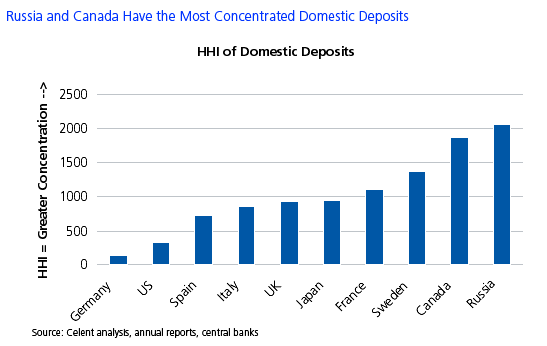The past 15 years have shown unprecedented concentration in the US commercial banking space. In 1995, the top five banks had 11% deposit share; today they have nearly 40%. How does this compare to other parts of the globe? Where is bank concentration so great that the banks are too big to bail out?
In a new report, Too Big to Bail? Bank Concentration in the Developed World, Celent looks at trends in deposit concentration across the globe. While concentration in the US has been increasing dramatically in the past 20 years, other countries experience far more deposit concentration, which means that competition can be reduced and systemic risk can be greater.
Greater bank concentration makes the industry more difficult to insure. A common measure of market concentration is the Herfindahl-Hirschman Index (HHI). Celent examines the HHI in banking for various countries and finds only two where bank concentration could be anticompetitive: Canada and Russia. In spite of its growing concentration, the United States it remains one of the least concentrated markets Celent examined.

"The greatest concern is that banks will become not just too big to fail, but too big to bail out," says Bart Narter, SVP of Celent's Banking Group and author of the report. "At what point does a government lose the ability to bail out its banks? How large should they be allowed to grow?"
The US FDIC has established a 10% limit on domestic deposit market share. In other countries, banks routinely exceed this limit.
This report also compares the concentration of deposits in various European countries and the credit default swap (CDS) spread of the banks in the market and of the sovereign debt.





